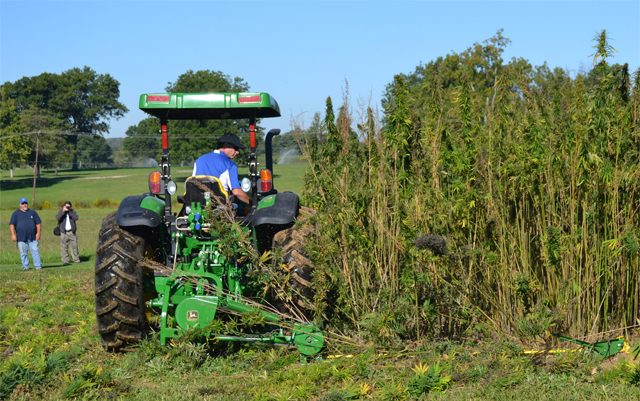Grandpa Don c. 1954
Never has there been a more controversial crop than hemp. Arguments against agricultural hemp are tenuous to say the least. Fighting about the legalization of hemp is like fighting about the legality of corn. Industrial hemp has more than 5,000 applications in the textile industry, and another 25,000 uses that include dynamite and cellophane. Not one of those uses includes getting high.
The THC levels in industrial hemp are so low (below 1 percent) that no one could get high from smoking it. To be clear, industrial hemp contains cannabinoids such as Tetrahydrocannabinol, CBD and CBN; however, due to man-made limitations, the THC requirements on industrial hemp state that the THC levels be no greater than 0.3 percent. Furthermore, hemp has such high levels of CBD (cannabinoids) that it actually blocks the psychoactive effects. David P. West, Ph.D. for the North American Industrial Hemp Council, expressed that, “Hemp, it turns out, is not only not marijuana, it could be called ‘antimarijuana.’”
So what’s the controversy all about?
The Hemp Controversy
Hemp is rooted in misinformation, stigma and a confusing history. For medieval Europeans, hemp referred to fiber. In the 1890s, hemp referred only to marijuana-hemp. Then, in the 1930s, the Bureau of Narcotics used hemp to describe all forms of cannabis and it became illegal.
The truth is that just like corn is made up of different varieties, “there are three fairly distinct types of hemp: that grown for fiber, that for birdseed and oil and that for drugs,” Dr. Andrew Wright described in 1918.
While hemp is in fact a subset of the species Cannabis Sativa, hemp is not the same thing as cannabis. They are grown differently and harvested at a different time. You wouldn’t want to grow hemp and cannabis at the same time as the occurrence of cross-pollination can and often will reduce the potency of both plants.
The good news is that more than two-dozen countries and 29 states have defined industrial hemp as distinct from cannabis and removed its barriers to production, but still, the United States and many constituents remain unconvinced.
“We have to get hemp separated from marijuana on the federal level and allow our farmers to grow it across the country,” shared Morris Beegle, Founder and President of the Colorado Hemp Company. “There are tremendous opportunities for a crop that’s been grown for 10,000 years and shunned for the last 75.”
“We have to get hemp separated from marijuana on the federal level and allow our farmers to grow it across the country. There are tremendous opportunities for a crop that’s been grown for 10,000 years and shunned for the last 75.” -Morris Beegle
Uses of Hemp
“Most people who support cannabis would support hemp if they were more familiar and educated about all the different things that it can do,” Beegle admitted. The problem is a lack of information. For example, did you know:
*In the last half of the 19th century, 50 percent of U.S. medicine was made from hemp.
*Hemp is the strongest natural fiber of any source and is resistant to rot and abrasion.
*Hemp fibers are so strong they can be used to make anything from skateboard decks to stealth fighter jet bodies, ship rigging and parachute webbing.
*Hemp concrete is 1/9 the weight of normal concrete, can be used in home building and works as insulation.
“You can make super capacitors, storage devices and plastic out of hemp,” Beegle revealed, “Basically, everything you can make from corn, you can make from hemp, and hemp is a healthier and better crop. All the stuff that’s made from petrochemicals, including oil, can be made with hemp.” Hemp fuel even burns cleaner than other fuels. It only produces energy, water vapor and CO2, which can be absorbed by plants for a sustainable cycle.
But hemp isn’t just great for the economy; it’s good for the environment. It can grow nearly anywhere in the world and in many types of soil. Even better, hemp has a short 120-day harvest cycle, does not require pesticides and purifies the soil where it’s planted. “Our commodities market, agricultural-wise, is really tough,” Beegle shared. “Farmers have a hell of a time making money with corn, wheat and hay. However, when you plant hemp, everything from the stocks, flowers, grain and root can be utilized to make things, so farmers can make far more per acre than they can with traditional crops.”
How Can Readers Get Involved with Hemp?
You can get involved by reaching out to your legislatures, and don’t forget to check out http://votehemp.com andhttp://nationalhempassociation.org.
As for Beegle, “My number one recommendation is to start buying hemp products. Start allocating some of your monthly income to use on hemp-based products. If you vote with your wallets, that will make a difference.”
You can also help by sending your #End420Shame story into DOPE. We’d love to hear from you. Contact us on social media or send an email to kellyv@dopemagazine.com
Colorado Hemp Company started in 2012 and has become a leading organization for the advancement and advocacy of hemp farming, processing, production, innovation, education and legalization. They support all things hemp and, each year, they hold the NoCo Hemp Expo, which brings together 130 exhibitors and 70 speakers dedicated to hemp.






